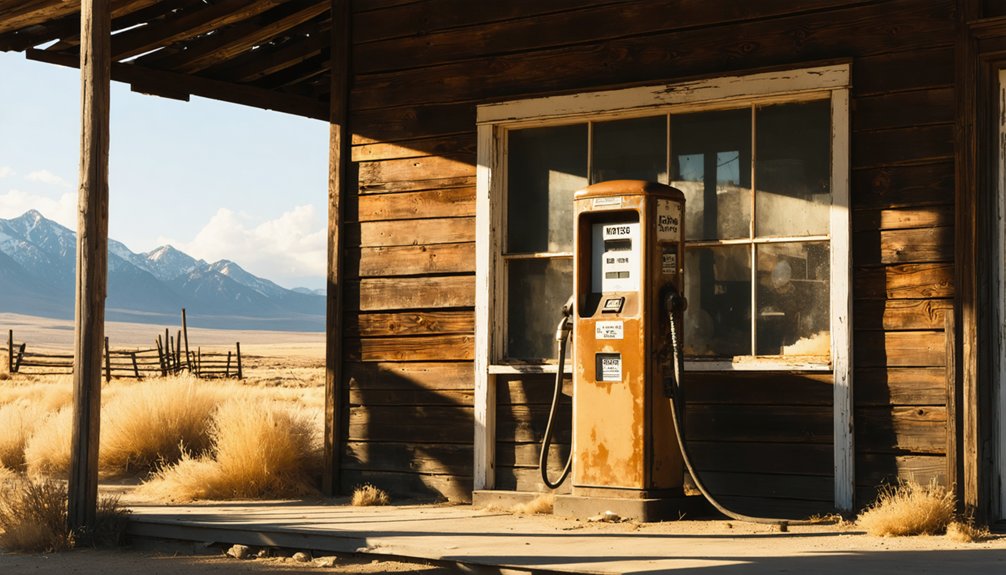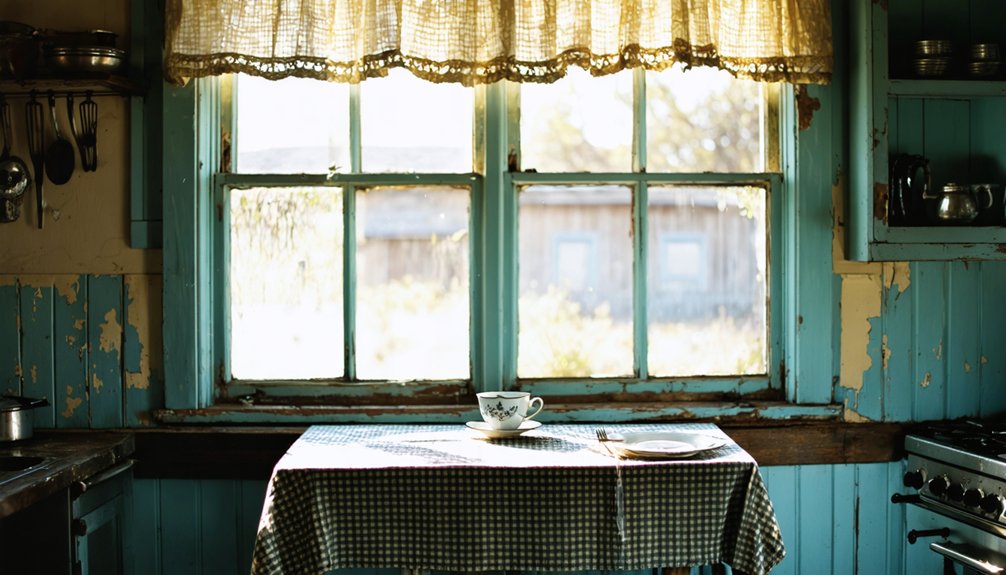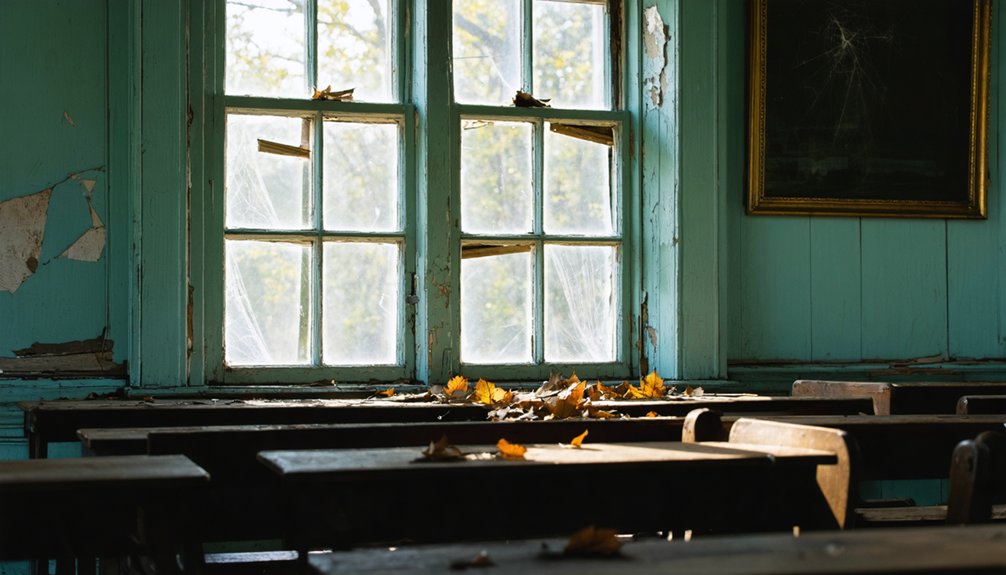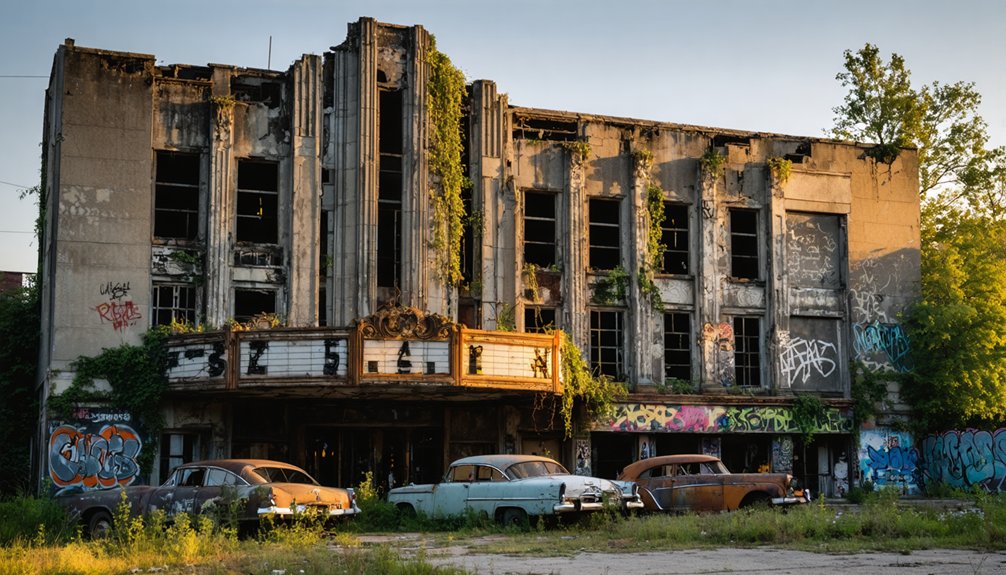America’s abandoned ghost towns captivate with their eerie silence and frozen-in-time allure. You’ll find weathered wooden storefronts, rusted mining equipment, and nature slowly reclaiming human settlements. Places like Bodie, California with its 110 buildings in “arrested decay” and Centralia, Pennsylvania with its underground fires offer haunting glimpses into frontier life suddenly halted. The golden hour casts dramatic shadows across these forgotten places, where every peeling paint chip and moss-covered foundation tells a story of boom and bust.
Key Takeaways
- America’s ghost towns capture the eerie silence of abandoned places, with Texas containing the highest number at 511 settlements.
- Preserved towns like Bodie, California maintain “arrested decay” with 110 original structures frozen in time since 1915.
- Nature slowly reclaims abandoned settlements, with moss-covered buildings and native vegetation creating hauntingly beautiful landscapes.
- Mining towns showcase boom-and-bust narratives through weathered storefronts, rusting equipment, and buildings illuminated dramatically at dusk.
- Photographers capture decay’s aesthetic through peeling paint, rusted hinges, and golden hour shadows that accentuate structural textures.
The Haunting Silence of America’s Forgotten Places

When you step into America’s abandoned ghost towns, an overwhelming silence envelops you like a heavy blanket. The wind whispers through decaying structures, occasionally punctuated by the creak of weathered boards or distant wildlife calls.
In places like Centralia, Pennsylvania, this quiet carries an unsettling undertone—the constant rumble of underground coal fires burning for decades.
These silent reflections offer a stark contrast to our noisy modern existence. You’ll find yourself caught in the emotional resonance of emptiness, where time stands still and nature slowly reclaims human endeavors. Cities like Gary, Indiana and Detroit show the aftermath of economic decline, with thousands of vacant homes standing as monuments to once-thriving communities.
Texas contains the highest number of ghost towns in America with 511 abandoned settlements, each telling a unique story of boom and bust cycles throughout the state’s history.
The stillness in Bodie, California, preserved by strict regulations protecting every dusty artifact, speaks volumes about impermanence.
Many visitors report feeling watched despite the absence of people—a sensation amplified by the oppressive quiet that disconnects you from the world you know.
Snapshots of Time: America’s Best-Preserved Ghost Towns
You’ll step back in time when visiting Bodie, California, where 110 buildings stand preserved in “arrested decay” with untouched interiors revealing life as it was when the last residents fled.
In Colorado’s St. Elmo, the well-preserved mountain ghost town invites you to wander among original structures where 2,000 miners once sought fortune before the ore quality diminished in the late 1880s.
Visitors to Centralia, Pennsylvania witness the apocalyptic landscape where toxic smoke continues to rise from a decades-long underground fire that has turned the once-thriving mining town into a hazardous wasteland.
These silent witnesses to America’s mining heritage offer you rare glimpses into authentic frontier life, frozen at the moment of abandonment.
The bottle house in Rhyolite, Nevada stands as a remarkable example of frontier innovation, constructed entirely from discarded glass bottles during the town’s brief but vibrant gold rush period.
Bodie’s Frozen Moment
Perched at a breathtaking 8,379 feet in California’s Sierra Nevada Mountains, Bodie stands as America’s quintessential ghost town frozen in time.
Once home to 8,000 gold-seeking souls, today you’ll find 110 buildings in “arrested decay”—preserved exactly as residents left them when the boom went bust.
You can wander streets where 2,000 structures once stood, peering through windows at homes still furnished with personal belongings, as if their owners might return any moment.
The remote location that once challenged miners now serves as Bodie’s greatest protection, keeping this National Historic Landmark authentic since being abandoned in 1915.
The Standard Mill, jail, and Methodist church offer glimpses into frontier life, carefully maintained in their weathered state—a deliberate preservation approach letting you experience genuine Bodie history without modern intrusions. For visitors seeking clarification about various references to “Bodie,” this ghost town represents just one of many disambiguation topics bearing the name. Daily tours of the Standard Stamp Mill provide visitors with educational insights into the gold extraction process that once drove the town’s economy.
St. Elmo’s Living Past
While Bodie stands frozen in California’s high Sierra, another American time capsule beckons from the heart of Colorado’s Sawatch Range.
St. Elmo, established in 1880 during the mining boom, remains one of America’s best-preserved ghost towns where you’ll walk streets once bustling with 2,000 souls.
You’re treading through authentic history here. The town’s spectacular rise yielded over $60 million in gold before economic winds shifted in the 1920s.
By 1930, only seven residents remained, including the Stark family who maintained St. Elmo‘s pulse for decades.
Today, their mining legacy lives on through preserved structures, earning National Historic District status in 1979.
As you explore the original storefronts and schoolhouse, don’t dismiss tales of spectral sightings—Annabelle Stark’s presence reportedly lingers, slamming doors and chilling rooms in this mountain sanctuary. Visitors can shop for supplies at the general merchandise store that operates from May through October. Located at nearly 10,000 feet elevation, the town offers breathtaking views of the surrounding mountains.
When the Gold Rush Ended: Mining Towns Frozen in Time

When you walk through America’s abandoned mining towns, you’re witnessing the dramatic lifecycle of gold rush communities that exploded into existence and died just as quickly when precious metals vanished.
The wooden storefronts, rusty mining equipment, and half-collapsed stamp mills tell the story of economic boom and bust more vividly than any history book could.
Towns like Bodie, California exemplify this narrative with 110 structures remaining from its 1859 founding and subsequent decline by the 1910s.
You’ll find these frozen-in-time settlements particularly haunting at dusk, when the golden light illuminates weathered buildings that once housed thousands of optimistic fortune-seekers who left almost everything behind when the gold ran out.
Many of these ghost towns, including the famous Rhyolite in Nevada, serve as stark reminders of the boom and bust patterns that characterized mining communities throughout the American West.
Boomtown to Bust
As the glittering promise of gold and silver lured thousands to remote Western landscapes in the late 19th century, few miners contemplated the inevitable cycle that would leave their bustling communities frozen in time.
You’ll find these once-vibrant towns trapped in economic shifts, their cultural legacies preserved in weathered facades and rusting machinery.
- Bodie’s abandoned railroad in 1918 severed its lifeline to civilization
- Monte Cristo’s devastating floods in 1896-1897 washed away not just buildings but hope itself
- Goldfield transformed from Nevada’s largest city to a hollow shell when ore quality plummeted
- St. Elmo’s 2,000 residents vanished as silver veins faulted and profits dwindled
- Rhyolite’s meteoric rise ended in complete abandonment by 1916, just as rapidly as it had grown
The earth’s treasures, once depleted, left these dreamers’ paradises to crumble back into dust.
Preserved Mining Artifacts
Five ghost towns across America offer time capsules of mining life, their artifacts frozen in the moment workers laid down their tools for the last time.
In Burke, Idaho, you’ll find railroad tracks cutting through buildings, while Kennecott’s massive copper mill stands as a monument to industrial ambition within Alaska’s wilderness.
Wander through Garnet, Montana’s 80 standing structures where peeling wallpaper, toys, and rustic furnishings reveal the human side of mining heritage.
In Bodie, California, 110 original buildings showcase the historical significance of the 1870s gold rush era.
Most remarkable is that Pacific Northwest copper mine where century-old tools remain exactly where miners last placed them—ventilation systems still intact, original timbers still supporting passageways, creating an authentic window into America’s industrial past.
Nature Reclaims: Ghost Towns Surrendering to the Elements
Once thriving centers of American frontier ambition, ghost towns now surrender to nature’s patient reclamation project.
You’ll witness decay’s artistry as moss drapes over crumbling wooden structures in places like Cahawba, Alabama, where forests reclaim streets that once bustled with commerce.
Nature’s reclamation transforms human endeavors into haunting tableaus frozen between existence and oblivion.
- Wooden buildings slowly yielding to moisture, temperature fluctuations, and time’s persistent touch
- Former streets now carpeted with native vegetation, welcoming wildlife back to their original habitats
- Mine tailings gradually covered by pioneer species as ecosystems heal from industrial scars
- Weathered general stores standing as silent sentinels while chipmunks scamper through broken windows
- “Arrested decay” preservation efforts creating a delicate balance between remembrance and renewal
- Shoot at golden hour for dramatic shadows that accentuate structural textures
- Use tripods for long exposures in dim interiors with minimal light
- Incorporate leading lines to draw viewers through doorways and corridors
- Seek out building-specific elements that reveal the town’s original purpose
- Respect fragile structures—tread lightly and preserve what remains
- Rhyolite’s abandoned bank building stands as a haunting symbol of vanished wealth
- Calico transformed from silver hotspot to carefully preserved tourist destination
- Bannack’s wooden structures silently guard Montana’s first territorial capital
- Kennicott’s industrial ruins showcase the copper empire that once flourished in Alaska
- Ghost town legends of gunfights and vigilante justice echo through Tombstone and Deadwood
- https://devblog.batchgeo.com/ghost-towns/
- https://www.loveexploring.com/gallerylist/188219/the-us-state-with-the-most-ghost-towns-revealed
- https://www.geotab.com/ghost-towns/
- https://www.ranker.com/list/american-ghost-towns/alby-thompson
- https://en.wikipedia.org/wiki/Lists_of_ghost_towns_in_the_United_States
- https://www.atlasobscura.com/lists/americas-best-preserved-ghost-towns
- https://www.youtube.com/watch?v=Z69cNeuZGsA
- https://joybird.com/blog/top-ghost-towns-in-america/
- https://247wallst.com/special-report/2021/05/19/30-american-ghost-towns-7/
- https://themortgagepoint.com/2024/10/25/americas-new-ghost-towns/
Submerged Settlements: The Underwater Ghost Towns of America

While nature reclaims abandoned towns above ground, another category of ghost towns tells an even more haunting tale—those resting silently beneath America’s waters.
These submerged communities were sacrificed for progress as hydroelectric dams and reservoirs flooded entire settlements.
You’ll find Ferguson, South Carolina partially visible in Lake Marion, its kiln jutting above water like a sentinel.
During rare droughts, Old Bluffton emerges from Lake Buchanan, revealing its mid-1800s bones.
Andersonville’s remains hide beneath Lake Hartwell, accessible only by boat to the small island marking its former location.
For the adventurous, underwater exploration of these towns offers a surreal glimpse into frozen moments of American life.
When water levels recede, you can walk streets that once bustled with commerce—brief windows into communities that unwillingly surrendered to our nation’s expanding needs.
Photographing Decay: Capturing Ghost Town Architecture
Through the viewfinder of your camera, abandoned architecture transforms into a mesmerizing subject that tells stories of American ambition, decline, and the relentless passage of time.
Mastering ghost town photography requires both technical skill and narrative vision to document these vanishing monuments of history.
Ghost towns whisper their histories to patient photographers who bring both camera expertise and storytelling sensibility.
When capturing decay details, you’ll find the soul of these forgotten places lives in peeling paint, rusted hinges, and weathered wood textures. Architectural storytelling emerges from the contrast between wide-angle shots and intimate close-ups of distinctive features.
Last Residents: Stories From Those Who Stayed Behind

Behind the crumbling facades and weathered storefronts of America’s ghost towns, a handful of resilient souls remained long after the exodus. In Centralia, Pennsylvania, you’ll find the stubborn few who stayed despite toxic underground fires creating sinkholes beneath their feet. Their community survival instinct defied government relocation efforts, even as their neighbors fled.
Last resident struggles in places like Picher, Oklahoma reveal the harsh reality of contamination and isolation. By 2010, only twenty people remained amid lead-poisoned soil, with infrastructure crumbling around them.
When you explore Detroit or St. Louis today, you’ll discover neighborhoods where abandonment happened gradually—homes emptied one by one as industries collapsed.
The psychological toll on those who stayed behind is profound, their daily lives marked by limited services and the haunting emptiness of once-thriving streets.
Western Legends: Ghost Towns of the American Frontier
When you journey across the rugged landscapes of the American West, you’ll encounter the weathered remains of once-thriving communities that sprung to life during the frenzied expansion between 1880 and 1940.
These mining boomtowns rose rapidly as prospectors chased dreams of gold, silver, and copper, only to collapse when deposits vanished or commodity prices plummeted.
Railroads determined survival—when trains bypassed towns or stopped running, freedom-seeking pioneers moved on, leaving behind these skeletal monuments to America’s frontier spirit.
Planning Your Ghost Town Adventure: Safety and Etiquette

While the romantic allure of these forgotten settlements beckons explorers from far and wide, venturing into ghost towns requires careful planning and respect.
Before setting off, research ghost town regulations, as many sites sit on private land where trespassing carries stiff penalties. Always secure permission and heed posted warnings—those “No Trespassing” signs aren’t mere suggestions.
Prioritize your safety with essential gear: sturdy boots, protective clothing, respirators for dusty interiors, and first aid supplies.
When exploring structures, assess stability from the outside first—crumbling foundations and sagging roofs signal danger. Travel with companions, share your itinerary with someone reliable, and download offline maps for areas with no cell service.
Frequently Asked Questions
Are Ghost Towns Legally Protected From Development or Demolition?
You’ll find ghost town preservation varies by ownership status. Public sites with historical significance enjoy strong legal protection, while privately owned ghost towns can be developed unless formally designated as historic landmarks.
Can Ghost Towns Be Purchased by Private Individuals?
Yes, you can purchase ghost towns as private property. You’ll navigate complex ownership laws, but these weathered relics of bygone eras can become your personal piece of untethered American history.
How Do Researchers Determine When a Town Became “Officially” Abandoned?
You’ll find researchers determine abandonment through multiple criteria: declining population records, cessation of economic activity, deteriorating physical structures, and historical significance markers—each telling the haunting tale of freedom-seekers who’ve long departed these forgotten places.
Do Any Ghost Towns Have Paranormal Investigation Opportunities?
Like moths to a flame, you’ll find numerous ghost towns offering paranormal tours. St. Elmo, Bodie, and Frisco welcome ghost hunting enthusiasts to explore their haunted ruins and discover whispers from the past.
Which Ghost Towns Are Most Accessible for Visitors With Mobility Limitations?
You’ll find Jerome, Arizona and Bannack, Montana most welcoming with their accessible routes for mobility aids. Terlingua, Texas offers paved paths where your wheels can roll through history’s dusty remnants.



